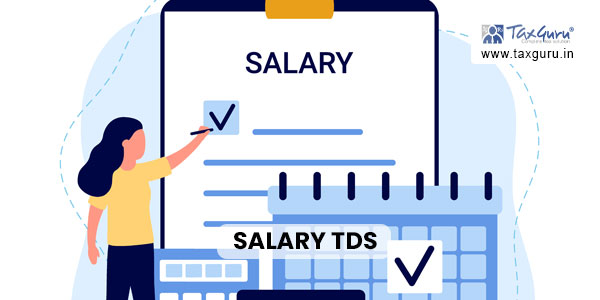SECTION 192 OF THE INCOME TAX 1961 APPLICABILITY
Section 192 of the Income Tax Act, 1961 is applicable to all employers who are responsible for deducting tax at source from the salaries of their employees. This section applies to all types of employees, including full-time, part-time, and contractual employees, as long as they are earning a salary.
Under this section, the employer is required to deduct TDS (Tax Deducted at Source) from the salary of an employee at the time of making payment. The TDS is calculated on the basis of the income tax slab rate applicable to the employee’s income.
In addition to this, the employer is also required to issue Form 16 to the employee, which shows the details of TDS deducted from their salary during the financial year. This form is used by the employee to file their income tax returns.
Therefore, if you are an employer who pays a salary to employees, you are required to comply with the provisions of Section 192 of the Income Tax Act, 1961.
The tax rate for salaried employees under Section 192 of the Income Tax Act, 1961, depends on the income tax slab rate applicable to the employee’s income.
As of the financial year 2022-2023, the income tax slab rates for salaried individuals are as follows:
(A) For Individual (resident or non-resident) less than 60 years of age anytime during the previous year:
| Existing Tax Regime | |
| Income Tax Slab | Income Tax Rate |
| Up to ₹ 2,50,000 | Nil |
| ₹ 2,50,001 – ₹ 5,00,000 | 5% above ₹ 2,50,000 |
| ₹ 5,00,001 – ₹ 10,00,000 | ₹ 12,500 + 20% above ₹ 5,00,000 |
| Above ₹ 10,00,000 | ₹ 1,12,500 + 30% above ₹ 10,00,000 |
–
| New Tax Regime u/s 115BAC | |
| Income Tax Slab | Income Tax Rate |
| Up to ₹ 2,50,000 | Nil |
| ₹ 2,50,001 – ₹ 5,00,000 | 5% above ₹ 2,50,000 |
| ₹ 5,00,001 – ₹ 7,50,000 | ₹ 12,500 + 10% above ₹ 5,00,000 |
| ₹ 7,50,001 – ₹ 10,00,000 | ₹ 37,500 + 15% above ₹ 7,50,000 |
| ₹ 10,00,001 – ₹ 12,50,000 | ₹ 75,000 + 20% above ₹ 10,00,000 |
| ₹ 12,50,001 – ₹ 15,00,000 | ₹ 1,25,000 + 25% above ₹ 12,50,000 |
| Above ₹ 15,00,000 | ₹ 1,87,500 + 30% above ₹ 15,00,000 |
SPECIAL NOTE:
1. The rates of Surcharge and Health & Education cess are same under both the tax regimes
2. Rebate u/s 87-A Resident Individual whose Total Income is not more than ₹ 5,00,000 is also eligible for a Rebate of up to 100% of income tax or ₹ 12,500, whichever is less.
This Rebate is available in both tax regimes.
Surcharge, Marginal Relief and Health & Education Cess
What is Surcharge?
Surcharge is an additional charge levied for persons earning Income above the specified limits, it is charged on the amount of income tax calculated as per applicable rates
- 10% – Taxable Income above ₹ 50 lakh – up to ₹ 1 crore
- 15% – Taxable Income above ₹ 1 crore – up to ₹ 2 crore
- 25% – Taxable Income above ₹ 2 crore – up to ₹ 5 crore
- 37% – Taxable Income above ₹ 5 crore
- Maximum rate of Surcharge on Income by way of Dividend or Income under the provisions of Sections 111A, 112A and 115AD is 15%
What is Marginal Relief?
Marginal relief is a Relief from Surcharge, provided in cases where the Surcharge payable exceeds the additional income that makes the person liable for Surcharge. The amount payable as Surcharge shall not exceed the amount of income earned exceeding ₹ 50 lakh, ₹ 1 crore, ₹ 2 crore or ₹ 5 crore respectively.
What is Health and Education cess?

Health & Education cess @ 4% shall also be paid on the amount of income tax plus Surcharge (if any).
CBDT Circular : F. No.370142/06/2023-TPL dated 05th April, 2023
Department issued an Clarification regarding deduction of TDS under section 192 read with sub-section (IA) of section 115BAC of the Income-tax Act, 1961, Text of the circular are given below:-
1. Vide Finance Act, 2023, sub-section (lA) has been inserted in section 115BAC of the Income-tax Act, 1961 ( the Act) to provide for a new tax regime with effect from the assessment year beginning on or after the 1st day of April, 2024. This regime applies to an individual or Hindu undivided family or association of persons [other than a cooperative society] or body of individuals, whether incorporated or not, or an artificial juridical person.
2. Under this new regime, the income-tax in respect of the total income of the person shall be computed at the rates provided in sub-section (1 A) of section 115BAC, subject to certain conditions, including the condition that the person does not avail of specified exemptions and deductions.
3. The above mentioned new tax regime is the default tax regime applicable to all persons mentioned above. However, under sub-section (6) of section 115BAC of the Act, a person may exercise an option to opt out of this tax regime. A person not having income from business or profession can exercise this option every year.
4. Representations have been received expressing concerns regarding tax to be deducted at source (TDS) on salary income of a person under section 192 of the Act as the deductor, being an employer, would not know if the person, being an employee, would opt out from taxation under sub-section (1 A) of section 115BAC of the Act or not.
5. In order to avoid the genuine hardship in such cases, the Board, in exercise of powers conferred under section 119 of the Act, hereby directs that a deductor, being an employer, shall seek information from each of its employees having income under section 192 of the Act regarding their intended tax regime and each such employee shall intimate the same to the deductor, being his employer, regarding his intended tax regime for each year and upon intimation, the deductor shall compute his total income, and deduct tax at source thereon according to the option exercised.
6. If intimation is not made by the employee, it shall be presumed that the employee continues to be in the default tax regime and has not exercised the option to opt out of the new tax regime. Accordingly, in such a case, the employer shall deduct tax at source, on income under section 192 of the Act, in accordance with the rates provided under sub-section (lA) of section 115BAC of the Act.
7. It is also clarified that the intimation would not amount to exercising option in terms of sub-section (6) of section 115BAC of the Act and the person shall be required to do so separately in accordance with the provisions of the sub-section.
8. This circular is in supersession of Circular No. C1 of 2020 dated 13.04.2020 and shall be applicable for TDS during the financial year 2023-24 and subsequent years.
For Current Financial Year Related Tax Planning we are coming with New Article so please comment & follow your query or topics on which we are looking for an article.





